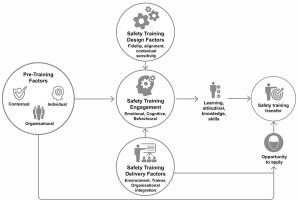Journal of Safety Research ( IF 3.9 ) Pub Date : 2021-06-25 , DOI: 10.1016/j.jsr.2021.06.004 Tristan Casey 1 , Nick Turner 2 , Xiaowen Hu 3 , Kym Bancroft 4

|
Introduction: Compared to other types of occupational training, safety training suffers from several unique challenges that potentially impair the engagement of learners and their subsequent application or “transfer” of knowledge and skills upon returning to the job. However, existing research on safety training tends to focus on specific factors in isolation, such as design features and social support. The aim of this research is to develop an overarching theoretical framework that integrates factors contributing to training engagement and transfer. Method: We conducted a comprehensive qualitative review of safety training research that was published between 2010 and 2020. We searched Web of Science, Scopus, and Google Scholar, yielding 147 articles, and 38 were included. We content analyzed article summaries to arrive at core themes and combined them with contemporary models of general occupational training to develop a rich model of safety training engagement and transfer. Results: We propose that training engagement is a combination of pre-training factors such as individual, organizational, and contextual factors, that interact with design and delivery factors. Safety training engagement is conceptualized as a three-component psychological state: affective, cognitive, and behavioral. Organizations should prioritize pre-training readiness modules to address existing attitudes and beliefs, optimize the safety training transfer climate, and critically reflect on their strategy to design and deliver safety training so that engagement is maximized. Conclusions: There are practical factors that organizations can use before training (e.g., tailoring training to employees’ characteristics), during training (e.g., ensuring trainer credibility and use of adult learning principles), and after training (e.g., integrating learned concepts into systems). Practical Applications: For safety training to ‘stick,’ workers should be affectively, cognitively, and behaviorally engaged in learning, which will result in new knowledge and skills, improvements in attitudes, and new safety behaviors in the workplace. To enable engagement, practitioners must apply adult learning principles, make the training relevant, and tailor the training to the job and individual needs. After training, ensure concepts are embedded and aligned with existing systems and routines to promote transfer.
中文翻译:

使安全培训更具粘性:更丰富的安全培训参与和转移模型
简介:与其他类型的职业培训相比,安全培训面临一些独特的挑战,这些挑战可能会损害学习者的参与度以及他们在重返工作岗位后对知识和技能的后续应用或“转移”。然而,现有的安全培训研究往往孤立地关注特定因素,例如设计特征和社会支持。本研究的目的是开发一个总体理论框架,该框架整合了有助于培训参与和转移的因素。方法:我们对 2010 年至 2020 年间发表的安全培训研究进行了全面的定性审查。我们搜索了 Web of Science、Scopus 和 Google Scholar,产生了 147 篇文章,其中 38 篇被纳入。我们对文章摘要进行内容分析以得出核心主题,并将它们与当代一般职业培训模型相结合,以开发出丰富的安全培训参与和转移模型。结果:我们建议培训参与是培训前因素的组合,例如个人、组织和背景因素,这些因素与设计和交付因素相互作用。安全培训参与被概念化为由三个组成部分的心理状态:情感、认知和行为。组织应优先考虑培训前准备模块,以解决现有的态度和信念,优化安全培训转移环境,并批判性地反思其设计和提供安全培训的策略,以便最大限度地提高参与度。结论:组织可以在培训之前(例如,根据员工的特点定制培训)、培训期间(例如,确保培训师的可信度和成人学习原则的使用)和培训之后(例如,将学到的概念整合到系统中)使用一些实用因素。实际应用:为了使安全培训“坚持”,工人应该在情感、认知和行为上参与学习,这将导致新的知识和技能、态度的改善以及工作场所的新安全行为。为了实现参与,从业者必须应用成人学习原则,使培训具有相关性,并根据工作和个人需求定制培训。培训后,确保概念嵌入并与现有系统和例程保持一致,以促进转移。











































 京公网安备 11010802027423号
京公网安备 11010802027423号